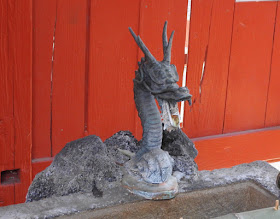目次 / Contents
1) オープン・ガーデン白岡 / "Open Garden Shiraoka
2) 白岡八幡神社 / Shiraoka Hachiman Shrine
1) オープン・ガーデン白岡 / "Open Garden Shiraoka
白岡市観光協会が主催する、"オープン・ガーデン白岡" は、個人宅を期日を決めて一般公開するイベントです。
白岡八幡神社は、常時一般公開されていますが、そのイベントに含まれていました。
 |
"オープン・ガーデン白岡" の冊子
Leaflet for "Open Garden Shiraoka"
 |
We went to Shiraoka-hachiman Shrine after "Cafe & amp; Gallery Nukunuku".
"Open Garden Shiraoka", sponsored by Shiraoka City Tourist Association, is an event when several individual's gardens are open to the public.
Shiraoka-hachiman Shrine is open to the public all the time but it was included in the event.
2) 白岡八幡神社 / Shiraoka-hachiman Shrine
白岡八幡神社は、思ったよりも立派で、その庭は素敵でした。
公式サイト : ★ / 境内マップ : ★
ここの庭が、"オープン・ガーデン白岡" に含まれる訳がわかりました。
Shiraoka-hachiman Shrine is more grant and its garden more lovely than I had thought.
Official Website : ★ / Inside Map : ★ (Both only in Japanese)
I understood the reasons that here is included in "Open Garden Shiraoka".
 |
|
にもかかわらず、他の二社と比べ、ここは知名度が低いです。
Shiraoka
Hachiman Shrine, Worship Hall
It
is said that this Shrine was founded in 849.
It
is regarded that Shiraoka Hachiman Shrine is one of the three Mioka Hachimangū Shrines in Japan, along
with Tsurugaoka
Hachimangū in Kamakura
Nevertheless, compared
with the other two shrines, here is little known.

本殿 / Main Building |
 |
| 御神木が立派! / Sacred Tree is Great! |
 |
十二支
瓦をベースにした、十二支のレリーフが奉納されていました。
この神社には、動物や鳥をモチーフにしたものが多く見られました。
Twelve Holy Signs : Twelve Branches
The reliefs of the Twelve Holy Signs were based on shapes of roof tiles
and were donated to the shrine.
I saw many dedicated things which used animals and birds as motifs in this Shrine. |
 |
神馬神社 / Horse God Shrine

説明文と昔話
Explanation and Legend of the Shrine in Japanese |
 |
白岡天満宮
白岡天満宮は、2009年に湯島天満宮から分霊されました。
Shiraoka Tenman-gū (Shrine)
天満宮は菅原道真公 (845 -903)を祀り、非常に多くの天満宮が日本にはあります。
公と牛の関係は深く、牛にまつわる伝承が多くあり、
牛は天満宮において神使 (シンシ) とされ、多くの(もしくはすべての?)
天満宮には臥牛 (ガギュウ/ 横たわった牛) の像が置かれています。
and there are so many Tenman-gū in Japan.
The relation between Sugawara-no-Michizane and the cow is deep.
There are many traditions related to him and the cow.
The cow is messenger of the god in Tenman-gū,
and many (or all?) Tenman-gū have statues of cows.
|
天満宮の他にも、複数の祠
(下の写真)
があります。
「どんな願い事もお引き受けします」(複合信仰)という感じがします。
それがあまり嫌な感んじではなく、胡散臭くもないのは、この場の気が良い体と思いました。
昔々から、地元民の願いをすくい上げる役割を果たしてきたのではないでしょうか?
ひとつの聖地であるように思います。
In
addition to Tenman-gū,
there are several shrines, below.
I
feel their approach is "We accept any wishes.(complex faith)"
I did not have a disappointed feeling and it was not suspicious, I think because here has good Qi.
Has here played a role of scooping up the wishes of the local people for a long time ?
I think that it is a sacred place.

三峰神社
[ミツミネジンジャ
/ 御眷属(山犬:
狼)信仰]と
小さな4つの祠
(ホコラ)
が並んでいます。
There
are four small shrines lined up :
|
| |
遊歩道 / Promenade
 |
よく手入れされています。 / It is well maintained.

大きな木を複数、庭作りに組み込むのは、一般住宅では難しいですが、
さすが、神社の庭です。
It is difficult for general houses to incorporate large trees into garden making,
but here is truly a shrine's garden. |
 |
小山が作られています。
They made a small hill. |
 |
滑り止めに年輪の柄が使用されています。
They use annual tree ring design to prevent slipping. |
 |
| 小山から / From Top of Hill |
 |
気が爽やかです。神社の地であるのを感じます。
I felt Qi was refreshing and here is the land of a shrine.

 |
 |
鐘堂
梵鐘 (ボンショウ) は、1675年に作られました。
ひっそりした場所にあり、使用されていないような感じです。
Bell Tower
The Bell was made in 1675.
It is in a quiet place and does not seem to be used. |
 |
| 神社入り口付近 / Around Shrine Entrance |
手水 舎 / Chōzuya
According to Wiki about Chōzuya,
"Chōzuya is a Shinto water ablution pavilion for a ceremonial purification rite known as temizu."
 |
| 無事かえる像 / Frog Statue for Safe Journeys |
 |
多くの場所で龍の口から水が出て、手水
舎に使用されていますが
ここは故障中でした。
In
many shrines the water for the Chōzuya, comes
out from the mouths of dragons,
but here was out-of-order.
|
 |
龍の木彫 / Dragon Wooden Carving
 |
駒止の杉 / Cedar for Tethering Horses

社伝では、源
義家 (1039
-1109) が奥州平定 (1062)の折戦勝祈願に立寄り、
駒をつないだといわれる「駒つなぎの杉」とされています。
1914年と1916年の2度にわたる落雷によって杉は倒れ、やむなく伐採され、
現在は二カ所に展示されています。
tied
the horse to the cedar which is now called "Cedar
for Tethering Horses"
and
prayed in the shrine before winning the Oshu War (1062).
The
tree was damaged by two thunderbolts in 1914 and 1916,
it
was forced to be logged, and now it is exhibited like this in two
places.
Incidentally,
Minamoto No Yoshiie's common name is Hachimantarō.
|
 |
写真を横にしてみると、私には龍のように見えます。
If we look at the photograph sideways, it can look like a dragon for me. |












































